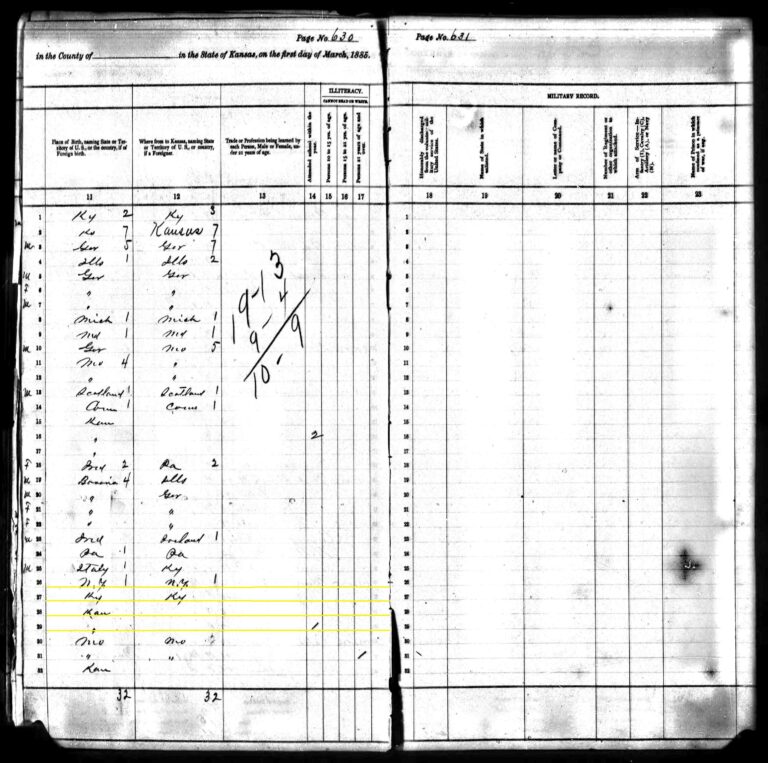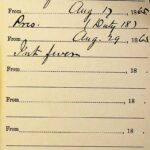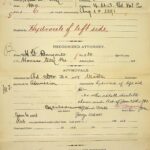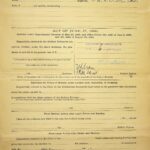Date of Birth
May 27, 1841
Place of Birth
Aubum, Cayuga Country, New York
Towns / Cities Moved Into
Kansas City, Wyandotte Country,Kansas
Known Occupation
US Civil War Soldier, Col. Miner
Abt. 1839-1845
Religion
-
Spouse
Death Information
Year of death
May 16, 1910
Place of death
Kansas City, Wyandotte Country, Kansas
Cause of death
-
Obituary

Parents

-

Henry Cohann Mundy
Marital Status


Married Susan elizabeth tinsley
Abt. 1845
Children


Narrative / Story
Lafayette Mundy’s life story unfolds against the backdrop of a vibrant and transforming New York City in the mid-19th century. Born on May 27, 1841, in Auburn, New York, his entrance into the world coincided with a period of burgeoning growth and profound change. At that time, New York was a bustling city, an economic powerhouse on the eastern coast of the United States, teeming with diverse communities and burgeoning with opportunities.
Lafayette “Fayette” Mundy’s story begins in the mid-19th century, a period marked by profound societal challenges. Born a “colored boy” from Sennett, a place known for its County Poor House, Fayette was received into the Cayuga Institute for Destitute Children on November 8, 1854, as a half orphan at the age of 8. This term indicated that one of his parents had died, leaving him in a vulnerable state, and he was being boarded at the Asylum by the surviving parent or guardian. His early life at the Institute was a reflection of the era’s hardships, yet it provided a semblance of stability in his formative years. On April 14, 1857, Fayette’s life took a turn when he was “taken on trial” by Henry Dwight for two months, a practice akin to a foster care system or indenture to learn a trade, aimed at teaching young individuals a skill for future independence. However, this arrangement was short-lived, and he was returned to the Institute on May 13, 1858, for reasons not documented. Demonstrating resilience and a desire for autonomy, Fayette eventually left the Institute “on his own hook,” a phrase suggesting he chose to leave and forge his own path into the world. Fayette Mundy’s journey from a vulnerable state in Sennett to seeking independence is a testament to the human spirit’s resilience in the face of adversity.
In this era, African American life was marked by stark contrasts. In the South, the harsh reality of slavery prevailed, while in the North, although free, African Americans like Lafayette faced significant racial discrimination. The Fugitive Slave Acts of the time cast a shadow over the lives of many, creating an atmosphere of uncertainty and fear. Despite these challenges, African American communities fostered a rich cultural and social life, blending African heritage with American influences, especially in music, folklore, and religious practices.
Amidst this complex social landscape, the Underground Railroad was actively facilitating the escape of slaves to free states and Canada. New York, with its bustling ports and diverse population, was a crucial hub in this clandestine network. The bravery of those involved in the Underground Railroad, both the conductors and the escapees, was a testament to the resilient spirit of the time, a spirit embodied by Lafayette Mundy.
Against this dynamic backdrop, Lafayette Mundy grew up to embody the resilience and determination characteristic of the era’s spirit. Despite early hardships, he matured into a robust young man, ready to take on the world.
Before his military service, Lafayette worked as a porter, a role that might have involved handling baggage, managing gates, or assisting passengers on railroads. This humble beginning, however, marked the start of a path that would lead him to remarkable bravery and commitment.
When the Civil War erupted, Lafayette, around 20 years old, joined the army on August 30, 1863, in New Orleans, Louisiana. He enlisted in Company A of the 4th US Colored Cavalry Regiment, a testament to the bravery of African American soldiers who fought for the Union and their own freedom. Rising to the rank of corporal, he demonstrated leadership and courage, participating in numerous battles and expeditions, including:
- Expedition from Yorktown to Matthews County, October 4-9, 1863.
- Wistar’s Expedition against Richmond, February 6-8, 1864.
- New Kent Court House, February 8, 1864.
- Expedition to Bottom’s Bridge in aid of Kilpatrick’s Cavalry, March 1-4, 1864.
- Expedition into King and Queen County, March 9-12, 1864.
- Expedition into Matthews and Middlesex Counties, March 17-21, 1864.
- Dutch Gap, September 7, 1864.
- Battle of Chaffin’s Farm, New Market Heights, September 28-30, 1864.
- Battle of Fair Oaks, October 27-28, 1864.
- 2nd Expedition to Fort Fisher, N.C., January 7-15, 1865.
- Assault and capture of Fort Fisher, January 15.
- Sugar Loaf Hill, January 19.
- Sugar Loaf Battery, February 11, 1865.
- Campaign of the Carolinas, March 1-April 26.
- Advance on Goldsboro, March 6-21.
- Occupation of Goldsboro, March 21.
- Cox’s Bridge, March 23-24.
- Advance on Raleigh, April 9-18.
- Occupation of Raleigh, April 14.
- Bennett’s House, April 26.
- Surrender of Johnston and his army.
- Duty in the Dept. of North Carolina until May 1866.
Lafayette’s military life was marked not only by courage but also by hardship. He faced health challenges, including intermittent fever, common in Civil War camps, and a severe injury from a horse fall near Port Hudson, which left him with a lasting physical ailment and long-term effects on his health.
After the Civil War, Lafayette Mundy made a pivotal decision in his personal life by marrying Susan Elizabeth Tinsley Mundy on June 27, 1873, in Jack County, Texas. This union marked a new chapter in his life as he transitioned from a soldier to a family man.
Continuing his military career, Lafayette served as a Buffalo Soldier, a term used to describe African American cavalry soldiers in the post-Civil War era. His service took him to various locations, including Mexico. It was during this period, while stationed in Mexico, that Lafayette and Susan Elizabeth welcomed their son, Thaddeus S. Mundy, into the world. Thaddeus’s birth in Mexico added a unique international dimension to Lafayette’s already eventful life.
However, Lafayette’s personal journey was marked by changes and challenges. His marriage with Susan Elizabeth eventually ended in divorce in 1887. Despite the end of this chapter, life had more in store for Lafayette.
Later, he found companionship and love again when he married Louisa Jones, a widow, on September 21, 1892, in Independence, Jackson County, Missouri. This new union brought additional joy into his life as he and Louisa had two children, Lafayette Jr. and Pennie Mundy.
In his later years, Lafayette’s life was significantly impacted by the lingering effects of his war injury, for which he was granted a pension. He passed away on May 16, 1910, and was laid to rest at Oak Grove Cemetery in Kansas City, Wyandotte County, Kansas.
Lafayette Mundy’s life encapsulates a profound account of a black American’s journey through the mid-19th to the early 20th century, marked by personal struggles, military service in the Civil War, and a vibrant personal life. His journey through the tumultuous times of the Civil War and beyond reflects the broader struggles and triumphs of a nation and its people during one of the most challenging periods in American history.
Personal Stories / Anecdotes / Newspaper clippings
Auburn Daily Advertiser

Letter to Asylum








































